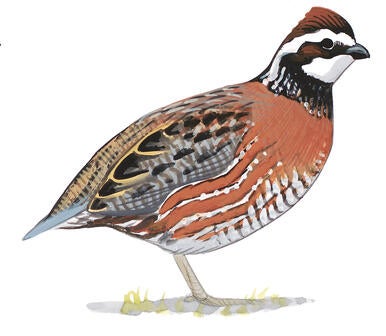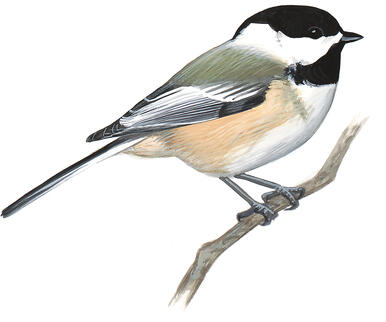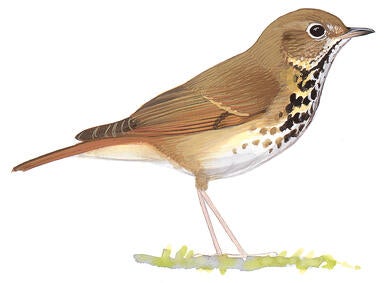What’s the Difference Between a ‘Borb’ and a ‘Floof’?
Now that we know what constitutes a birb, it's time to break down the internet's other two nicknames for birds.
It is a truth (nearly) universally acknowledged that birds exist. It is a truth somewhat less universally acknowledged that a portion of them are “birbs”: a somewhat ambiguous online avian classification encompassing the small (usually), the round (often), and the cute (always). To create clarity around this popular meme, Audubon proposed a set of carefully considered rules for parsing the birbs from the birds. Among the masses, a great rejoicing rang out—as well as much debate. And amid the hubbub came further questions: What about the other words that the internet, in its unending love of neologisms, has bestowed upon birds? What about “borbs” and “floofs”? Where do they fit into Audubon’s taxonomic rankings?
Consider then the borb. Urban Dictionary provides the canonical definition: a fat bird. This perceived fatness isn’t incidental to their appeal but central to it: Where the roundness of the classical birb is merely a component of its appeal, the borb is roundness. Their plush, planetary shapes exert a gravitational pull on our hearts and minds.
Consider then the borb. Urban Dictionary provides the canonical definition: a fat bird. This perceived fatness isn’t incidental to their appeal but central to it: Where the roundness of the classical birb is merely a component of its appeal, the borb is roundness. Their plush, planetary shapes exert a gravitational pull on our hearts and minds.
The name borb is likely a portmanteau of bird and orb. (An etymological search does turn up the old Irish word borb —“foolish, rude, uncouth”—which is interesting but surely unrelated.) It’s an unspoken rule of internet dialect that rounding a word intensifies the implicit fatness of its subject: Take the relationship between chunk and “chonk” in cats or the pig-affiliated meme “Bröther may I have some öats,” which uses umlauts to emphasize the uncanny size of its subjects. If birb is a rounder-sounding word than bird, then borb is the roundest sounding word: Speaking it forces the mouth into an O shape, echoing the shape of the beast itself.
As such, the key and sole criteria for a borb is roundness, a quality at least partially dependent on behavior and moment-to-moment activity. Save for penguins and other blubber-dependent bird species, most wild birds are not, strictly speaking, fat: Their high calorie diets are rapidly burned off by fast metabolisms and energy-intensive activities: running, foraging, and flying. That perceived fatness is often created by a bird's feathers, which essentially function as shape-shifting body suit that allows them to take on (sometimes startlingly) different appearances. Birds tend to fluff up in winter, trapping air between their feathers to keep warm; before bathing in dust or water; when applying ants for therapeutic purposes; or for purposes of display or signalling emotional reactions. As it happens, there’s an internet slang word for a fluffed-up bird, too: a floof.
Interestingly, a floof is not necessarily always a bird. The word refers to any abundantly fluffy creature. In mammals, floofiness is largely a passive attribute, but birds engage in it as a matter of behavior. Most birds—regardless of their status as birb— can floof at will. That means that birds otherwise locked out of the birb category can qualify as floofs: ostriches in full strut, ruffled birds of prey, and amorous grackles. On the other hand, smooth birds—i.e adult penguins—are not and cannot be floofs, because they lack the ability to fluff up their feathers. Floof is a weak noun and a strong verb: It is a way of life and one of the few things dogs, cats, and birds all have in common. We may therefore understand that a borb, like any other birb, is. A floof does.
Let us now apply this logic. Borbs as a category heavily intersect with birbs, defined as both are by roundness. But just as every bird is not a birb, every birb is not a borb. Some birds naturally have deep chests and short necks, easily securing their borbness: chickadees, European Robins, and Bearded Tits, the last of which seems to be the poster child for the type. Other clear borbs include pigeons, thrushes, warblers, game birds, small parrots, most owls, and penguins. While wading birds can appear remarkably compact, like a scrunched-up Green Heron, this is an illusion, a deception, a trick—they can only aspire to borbness. Some individual birds can also be borbs, even if their species at large doesn’t qualify: This particular sausage-loving Kookaburra, for example, sleepy lovebirds, or bread-fattened urban ducks (though Audubon wishes to make clear that you should keep a careful eye on your pet birds’ diet and never feed bread to waterfowl.) It's also important to remember that a borb can also be a floof, as the latter only requires the fluffing of feathers.
This, then, is Audubon’s taxonomy of birb: Birbs are small, round, and either cute or absurd; borbs are those birds that carry apparent roundness to an extreme; and most birds can floof when the mood suits them. Any amorphousness in this taxonomy is a feature, not a failure: Birds and words are both shape-shifting things, shrinking and growing by turns, flitting between categories. We can cage them for a time, but in the end, it’s always better to see them fly.



















